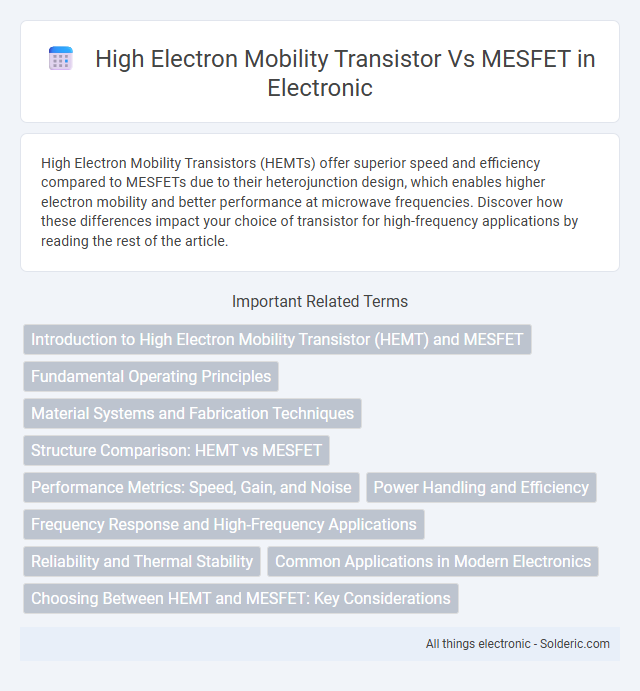High Electron Mobility Transistors (HEMTs) offer superior speed and efficiency compared to MESFETs due to their heterojunction design, which enables higher electron mobility and better performance at microwave frequencies. Discover how these differences impact your choice of transistor for high-frequency applications by reading the rest of the article.
Comparison Table
| Feature | High Electron Mobility Transistor (HEMT) | MESFET |
|---|---|---|
| Semiconductor Material | Typically GaAs, GaN, or AlGaAs | Typically GaAs or InP |
| Structure | Heterojunction between two semiconductor materials | Schottky gate junction on a single semiconductor layer |
| Electron Mobility | High (due to 2DEG channel) | Moderate |
| Frequency Performance | Very high cutoff frequency (tens to hundreds of GHz) | High cutoff frequency (several tens of GHz) |
| Noise Figure | Low noise figure | Higher noise figure than HEMT |
| Applications | Microwave amplifiers, RF front ends, high-speed switches | Microwave circuits, RF amplifiers |
| Operating Voltage | Typically low voltage operation (1-3 V) | Moderate voltage operation (3-5 V) |
| Power Efficiency | High power efficiency | Moderate power efficiency |
Introduction to High Electron Mobility Transistor (HEMT) and MESFET
High Electron Mobility Transistor (HEMT) operates by utilizing a heterojunction between two semiconductor materials to create a high-mobility two-dimensional electron gas, enabling superior speed and frequency performance. MESFET (Metal-Semiconductor Field-Effect Transistor) uses a Schottky barrier gate on a semiconductor substrate, offering robustness and simpler fabrication suited for microwave frequencies. Your choice between HEMT and MESFET depends on specific application requirements like power handling, noise figure, and frequency range.
Fundamental Operating Principles
High Electron Mobility Transistors (HEMTs) use a heterojunction between two semiconductor materials to create a high-mobility two-dimensional electron gas, enabling faster electron transport and higher frequency operation. MESFETs operate based on a metal-semiconductor junction forming a Schottky gate over a uniformly doped semiconductor, controlling current through depletion regions. Your choice between these devices depends on application needs for speed, frequency, and noise performance, where HEMTs usually offer superior electron mobility and gain.
Material Systems and Fabrication Techniques
High Electron Mobility Transistors (HEMTs) primarily use III-V compound semiconductors such as GaAs/AlGaAs or GaN/AlGaN, exploiting heterojunctions to achieve high electron mobility and faster switching speeds. MESFETs are typically fabricated using materials like GaAs or InP with Schottky gate contacts formed by metal-semiconductor junctions, enabling high-frequency performance with simpler fabrication steps compared to HEMTs. Advanced epitaxial growth techniques like molecular beam epitaxy (MBE) or metal-organic chemical vapor deposition (MOCVD) are essential for HEMT structures to create precise heterojunction interfaces, whereas MESFET fabrication relies more on ion implantation and diffusion processes to form source/drain regions.
Structure Comparison: HEMT vs MESFET
High Electron Mobility Transistors (HEMTs) feature a heterojunction structure combining different semiconductor materials, typically AlGaAs/GaAs, to create a high-mobility two-dimensional electron gas (2DEG) channel, whereas MESFETs utilize a homojunction with a single semiconductor material like GaAs. The HEMT's heterostructure reduces impurity scattering and enhances electron mobility significantly compared to the doped channel in MESFETs, which relies on a Schottky gate controlling a uniformly doped semiconductor layer. This structural distinction grants HEMTs superior high-frequency performance and lower noise figures in RF and microwave applications relative to MESFETs.
Performance Metrics: Speed, Gain, and Noise
High Electron Mobility Transistors (HEMTs) outperform MESFETs in speed due to their superior electron mobility, enabling faster signal processing and higher cutoff frequencies. In terms of gain, HEMTs achieve higher gain levels as a result of their heterojunction structure, which minimizes carrier scattering and enhances current flow. Noise performance is also better in HEMTs, making them preferable for low-noise applications that require high sensitivity and signal integrity.
Power Handling and Efficiency
High Electron Mobility Transistors (HEMTs) exhibit superior power handling capabilities compared to MESFETs due to their heterostructure design, which allows higher electron mobility and greater current density. HEMTs demonstrate enhanced efficiency in high-frequency applications by reducing noise and minimizing power loss, thus improving overall device performance. MESFETs, while effective in moderate power scenarios, typically lag behind HEMTs in efficiency and thermal management under high power operation.
Frequency Response and High-Frequency Applications
High Electron Mobility Transistors (HEMTs) exhibit superior frequency response due to their higher electron mobility and lower noise figure compared to MESFETs, enabling operation at frequencies exceeding 100 GHz. MESFETs, while effective for moderate microwave frequencies up to around 40 GHz, are limited by their channel doping and electron velocity, which restrict high-frequency performance. High-frequency applications such as radar systems, satellite communications, and millimeter-wave transceivers prefer HEMTs for enhanced gain, noise performance, and frequency stability.
Reliability and Thermal Stability
High Electron Mobility Transistors (HEMTs) exhibit superior reliability and thermal stability compared to MESFETs due to their heterojunction design, which reduces defect densities and traps. The wide bandgap materials used in HEMTs, like GaN or AlGaN, enable operation at higher temperatures and power levels without significant degradation. MESFETs, typically based on GaAs, show lower thermal tolerance and are more susceptible to performance drops under prolonged high-temperature stress.
Common Applications in Modern Electronics
High Electron Mobility Transistors (HEMTs) excel in high-frequency and low-noise applications, making them ideal for microwave communication systems, satellite receivers, and radar technology. MESFETs are widely used in RF amplifiers, particularly in mobile phones and wireless communication devices, due to their robustness and ease of fabrication. Your choice depends on the specific frequency, noise, and power requirements of your electronic system.
Choosing Between HEMT and MESFET: Key Considerations
Choosing between High Electron Mobility Transistor (HEMT) and MESFET hinges on factors like frequency performance, noise figure, and power efficiency. HEMTs excel in high-frequency and low-noise applications due to their superior electron mobility and heterojunction design, making them ideal for microwave and millimeter-wave systems. Your decision should weigh MESFET's robustness and cost-effectiveness against HEMT's enhanced performance in demanding RF and high-speed electronics.
High Electron Mobility Transistor vs MESFET Infographic

 solderic.com
solderic.com